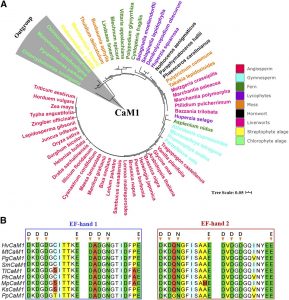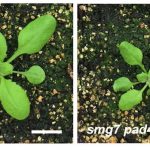Calmodulin and Salt Tolerance
 Salt stress is a major abiotic factor restricting crop growth and productivity. Excess sodium (Na+) causes ion toxicity and ion imbalances. Maintaining lower Na+ accumulation in shoots is crucial for salt tolerant plant species and genotypes under salt stress. Lower shoot Na+ accumulation in plants is attributed to either shoot Na+ exclusion or vacuolar sequestration, both of which are regulated by membrane transporters, including some types of High-affinity Potassium Transporters (HKTs), Activation of membrane transport systems in roots plays a key role in reducing shoot Na+ accumulation and enhancing salt tolerance in many plant species. Calcium (Ca2+) signaling is known to modulate Na+ transport in plants; however, the role of the Ca2+ sensor calmodulin (CaM) in salt tolerance requires further elucidation. Previously, a salt-responsive calmodulin (HvCaM1) was identified in the proteome of barley (Hordeum vulgare) roots. Shen et al. (10.1104/pp.20.00196) have now cloned HvCaM1 and comprehensively analyzed its function through overexpression and RNAi in barley using a variety of physiological and molecular techniques. They report that HvCaM1 is mainly expressed in roots and is significantly up-regulated in response to long-term salt stress. HvCaM1 is an intracellular signaling protein that localizes to the root stele and vascular systems of barley. After prolonged salt stress, HvCaM1 knock-down (RNAi) lines showed significantly larger biomass but lower Na+ concentration, xylem Na+ loading, and Na+ transport rates in shoots compared with overexpression lines and wild-type plants. The authors conclude that HvCaM1 negatively regulates salt tolerance, probably via interaction with the CaM-binding transcription activators HvCaMTA4 to modulate the downregulation of HvHKT1;5 and/or upregulation of HvHKT1;1 to reduce shoot Na+ accumulation under salt stress in barley.
Salt stress is a major abiotic factor restricting crop growth and productivity. Excess sodium (Na+) causes ion toxicity and ion imbalances. Maintaining lower Na+ accumulation in shoots is crucial for salt tolerant plant species and genotypes under salt stress. Lower shoot Na+ accumulation in plants is attributed to either shoot Na+ exclusion or vacuolar sequestration, both of which are regulated by membrane transporters, including some types of High-affinity Potassium Transporters (HKTs), Activation of membrane transport systems in roots plays a key role in reducing shoot Na+ accumulation and enhancing salt tolerance in many plant species. Calcium (Ca2+) signaling is known to modulate Na+ transport in plants; however, the role of the Ca2+ sensor calmodulin (CaM) in salt tolerance requires further elucidation. Previously, a salt-responsive calmodulin (HvCaM1) was identified in the proteome of barley (Hordeum vulgare) roots. Shen et al. (10.1104/pp.20.00196) have now cloned HvCaM1 and comprehensively analyzed its function through overexpression and RNAi in barley using a variety of physiological and molecular techniques. They report that HvCaM1 is mainly expressed in roots and is significantly up-regulated in response to long-term salt stress. HvCaM1 is an intracellular signaling protein that localizes to the root stele and vascular systems of barley. After prolonged salt stress, HvCaM1 knock-down (RNAi) lines showed significantly larger biomass but lower Na+ concentration, xylem Na+ loading, and Na+ transport rates in shoots compared with overexpression lines and wild-type plants. The authors conclude that HvCaM1 negatively regulates salt tolerance, probably via interaction with the CaM-binding transcription activators HvCaMTA4 to modulate the downregulation of HvHKT1;5 and/or upregulation of HvHKT1;1 to reduce shoot Na+ accumulation under salt stress in barley.



